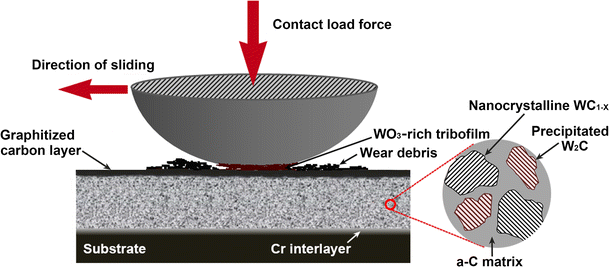Abstract: Nanocomposite WC/a-C coatings were successfully fabricated using a magnetron sputtering process, and post-deposition annealing was conducted in vacuum for 1 h at the annealing temperatures ranging from 100 to 500 degrees C. The changes in coating structure, internal stress, hardness, toughness, friction coefficient and wear have been investigated to assess the effects of annealing on microstructure, mechanical and tribological properties of the WC/a-C coatings. The results show that the nanocrystalline WC1-x partially decays to metastable W2C when annealing at 300-500 degrees C and no graphitization of amorphous carbon matrix starts up to 500 degrees C. This structural change results in a slightly increased hardness and an improved toughness as well as a gradually decreased internal stress. In addition, the time for the annealed coatings to achieve a low steady friction coefficient decreases with the increase of annealing temperature. An optimized tribological property with low friction coefficient of about 0.06 and enhanced wear resistance of the WC/a-C coating is obtained by annealing at 400 degrees C. Friction reduction and wear resistance caused by annealing can be attributed to the friction-induced WO3-rich tribofilm which slides against a thin carbon-rich layer on the coating surface resulting in a low friction, and the partition effect of the stationary WO3-rich tribofilm combining with the improved mechanical properties generates a high wear resistance. KeyWords Plus: CARBON-FILMS; THIN-FILMS; AMORPHOUS-CARBON; RAMAN-SPECTROSCOPY; TUNGSTEN CARBIDE; DIAMOND; WEAR; DEPOSITION; BEHAVIOR; STRESS Published in TRIBOLOGY LETTERS, 63 (2):10.1007/s11249-016-0699-2 AUG 2016
|
